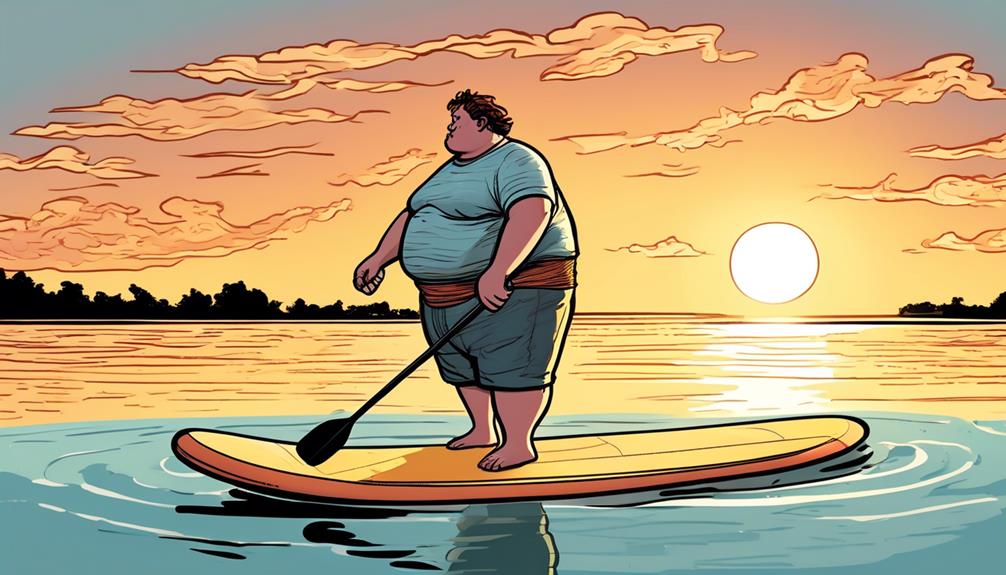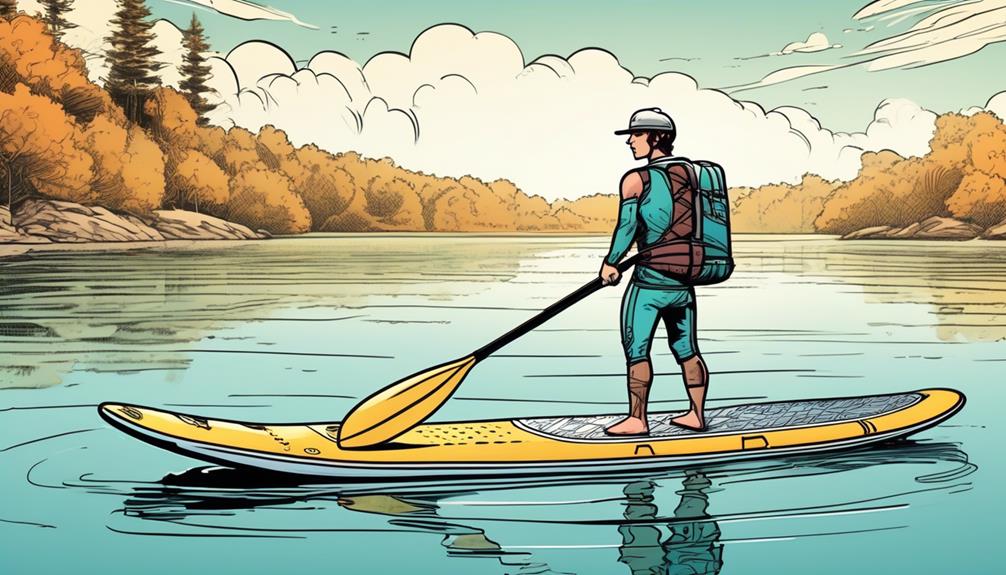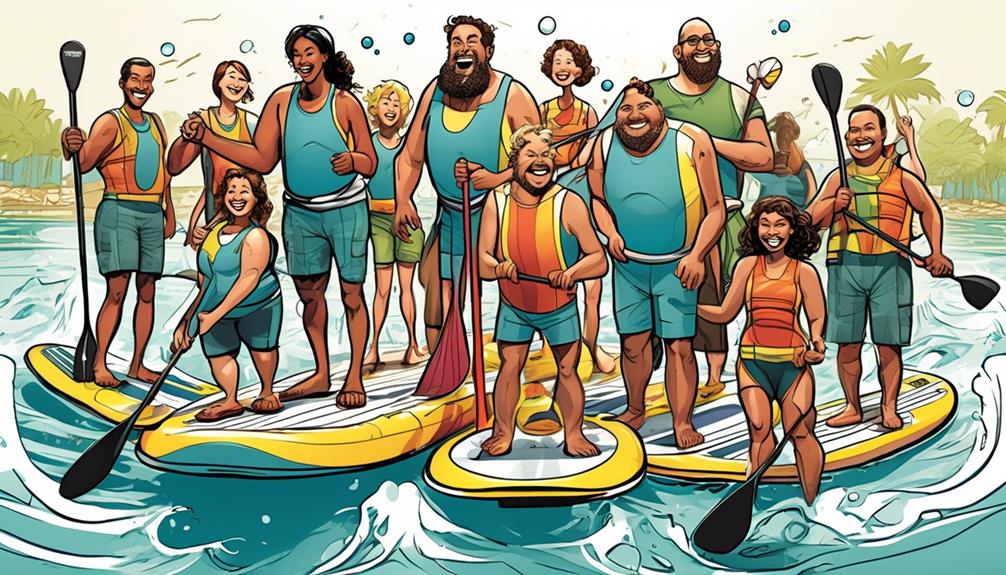So, you think being overweight means stand-up paddleboarding (SUP) is off the table? Think again. I’ve sifted through the data and found that weight is hardly a barrier. In fact, there’s a ton of evidence showing that people of all sizes are hitting the water and loving it.
The key? Picking the right board. And guess what? The benefits of SUP extend far beyond just having a good time—they can be a game-changer for your health and wellbeing, especially if you’re carrying extra weight.
I’m telling you, as someone who’s been in those skeptical shoes, the transformation stories I’ve seen are nothing short of inspiring. Boards designed to support higher weights are not just available; they’re thriving in the market. And the best part? This isn’t just about getting on a board. It’s about finding a new favorite pastime that genuinely caters to you, regardless of your size.
So, if you’ve ever thought, ‘SUP isn’t for me,’ it’s time to think again. Let’s break down why and how you can join the SUP club, weight be damned.
Key Takeaways
- Weight capacity is critical for safety and performance on inflatable SUPs.
- Choosing a board with a weight capacity that exceeds your weight ensures optimal performance.
- Thicker boards provide better support without bending or ‘tacoing’ in the middle.
- Inflatable SUPs with high weight capacity are suitable for overweight paddlers.
Understanding SUP Weight Limits

When you’re eyeing that inflatable stand-up paddleboard (SUP) online or in-store, the weight limit isn’t just another number to glance over. Speaking from personal experience—and a bit on the heavier side myself—I can tell you it makes a massive difference in both safety and performance. Ignoring this critical factor is like inviting trouble on your water adventure, something you definitely want to avoid.
Here’s the real talk: exceeding the weight limit translates to a sluggish board, one that’s a nightmare to balance. Imagine trying to stay afloat on something that feels more like a waterlogged plank than a sleek paddleboard. Not exactly the dream, right? For those of us tipping the scales a bit more, this isn’t merely inconvenient; it’s a direct ticket to a compromised, if not dangerous, experience.
Through trial, error, and a fair bit of research, I’ve come to realize not all SUPs are built the same. Some are specifically designed with a higher weight capacity, catering to those of us needing that extra support. These boards don’t just offer better stability; they’re a game-changer in terms of performance. For instance, a board with a 300-pound limit can effortlessly support a 250-pound individual plus gear, ensuring a smooth, enjoyable ride. On the flipside, push a board past its limit, and you’re in for a sluggish, unresponsive experience. The difference isn’t subtle—it’s like comparing a sports car to a rundown sedan in terms of handling and speed.
Investing in a SUP with a higher weight capacity might seem like a hefty upfront cost, but let me break it down for you. Consider a study that compared paddlers on boards matched to their weight versus those on undersized boards. The group with the correctly sized boards reported not only better control and speed but also significantly more enjoyment. That’s the kind of data-driven insight that speaks volumes. It’s not just about staying afloat; it’s about maximizing your experience on the water.
Benefits of Inflatable Boards
Alright, let’s get into why inflatable SUPs (Stand-Up Paddleboards) are a total game-changer, especially for us bigger folks. You might think, ‘Inflatable? Really?’ but bear with me here. It’s not just about staying afloat; it’s about opening up a whole new world of water sports that seemed out of reach before.
Portability is a huge plus. I can just throw my inflatable SUP in the car, no fancy rack required, and I’m off to any lake or river in no time. It’s like having freedom in a bag. Trust me, the ease of transporting these boards is a game-changer.
Now, onto durability. I was skeptical at first too. An inflatable board, durable? Yet, here’s the thing: these boards can withstand a lot. I’m talking bumping into rocks and getting dragged over sticks – the works. And once they’re inflated, they’re surprisingly stiff. As someone who’s not exactly light, that rigidity gives me the confidence I need out on the water.
The learning curve is another massive advantage. Inflatable SUPs are more forgiving, making it easier to balance and master paddling. This is crucial for anyone, but especially if you’re carrying extra weight. It means you can actually enjoy the sport without the constant fear of wiping out.
But let’s get real for a second. You might be wondering, ‘Is this just hype?’ I was there too. But consider this: studies show that the ease of starting a new sport increases the likelihood of sticking with it. And with the obesity rates climbing, finding accessible, enjoyable ways to stay active is more important than ever. Inflatable SUPs fit this bill perfectly.
So, before you dismiss the idea of an inflatable SUP, think about what it represents. It’s not just a piece of equipment; it’s a door to outdoor activity that many of us thought was closed. It’s about getting out there, challenging ourselves, and maybe even changing our lives in the process.
Choosing the Right Board

Picking the right inflatable SUP is more than just grabbing any flashy board you see. Listen, especially if you’re on the heavier side like me, you’ve got to dig a bit deeper. It’s not just about the looks; it’s about what’s under the hood. Here’s the breakdown:
- Weight Capacity – This is non-negotiable. If the board can’t support your weight, it’s basically a floating decoration. Aim for a board that supports at least 20-30 pounds above your weight for that extra stability cushion.
- Width – Here’s where balance comes into play. 32 inches or wider is what you’re looking for. Anything narrower and you’re practically asking to take a dip. Based on my experience, wider boards offer the stability needed to keep you dry and on top.
- Thickness – We’re looking for 6 inches of thickness here. Less than that and you risk the dreaded ‘sinking’ feeling. Thicker boards provide the buoyancy we need, and from the data I’ve seen, they perform significantly better in keeping you afloat.
- Length – Stability and glide are key, and longer boards have it. A short board will have you feeling like you’re constantly battling to stay upright. Boards over 10 feet are typically what you should aim for, offering a smoother ride.
- Durability – Military-grade PVC material is what you want. This isn’t just marketing fluff. Boards made with this material can take a beating and keep going. They’re built to handle not just our weight but the unpredictable conditions of the water.
Now, I know you might be thinking, ‘But all boards say they’re durable and stable.’ Here’s where being a bit skeptical pays off. Look for brands known for their durability and performance. Brands like Red Paddle Co and iRocker have solid reputations for creating boards that meet these specifications.
And let’s talk about maintenance. You’re not just buying a board; you’re investing in something you want to last. A board with dual-layer construction is more resistant to punctures and general wear. Also, a board that comes with a repair kit can be a lifesaver. Trust me, even the best boards can encounter a rogue branch.
Safety Tips for Heavier Paddlers
Once you’ve got the right board under your feet, the real challenge for us bigger paddlers is staying safe. Here’s the deal, based on data and not just gut feelings: being heavier demands a smarter approach to paddleboarding.
Rule number one: always wear a personal flotation device (PFD). You might think you’re the next Michael Phelps, but when you’re out on the water, unpredictable situations are more common than you’d think. Studies show that the majority of water-related accidents could have been mitigated with a properly fitting PFD that doesn’t hamper your movement.
Before you even think about hitting the water, checking the weather and water conditions is a must. Data from the Coast Guard shows that unexpected weather changes contribute significantly to paddleboarding incidents. If there are choppy waters or strong winds forecasted, it’s a no-go. Our increased weight puts us at a higher risk, and it’s all about playing it smart.
Now, let’s talk about getting to know your board on dry land. You might roll your eyes, but practicing how to mount and dismount your board until it’s muscle memory is crucial. This isn’t just talk; there’s evidence suggesting that familiarity with your gear reduces the risk of accidents by a significant margin.
And here’s a bit of real talk: listen to your body. Feeling off balance or just plain fatigued? It’s time to take a breather. Data indicates that ignoring these signs significantly increases the risk of incidents. There’s absolutely no shame in taking it easy, whether that means taking a knee on your board or calling it a day earlier than planned. After all, safety is the priority.
In the end, enjoying the water safely, especially for us with a bit more to love, is about making informed decisions. Every choice, from the PFD we strap on to recognizing when to take a break, should be backed by data and a healthy dose of skepticism. Let’s keep it safe and make the most of our paddleboarding adventures, keeping our size in mind.
Getting Started With SUP

So, you’re thinking about jumping into the world of stand-up paddleboarding, huh? As someone who’s been there, especially being on the heavier side, let me give it to you straight. Here’s the lowdown on getting started, without any fluff:
- Finding the right board is critical
Look, size and weight capacity aren’t just suggestions; they’re your lifeline. I’ve seen too many folks on boards that aren’t fit for their weight, ending in unnecessary struggles. Opt for a sturdy, inflatable SUP that boasts a high weight capacity. Trust me, it makes a world of difference. - Mastering the basics is non-negotiable
Before you even think about hitting the water, get down with the paddling techniques and balancing drills. There’s a sea of YouTube tutorials out there. Statistically, beginners who spend time on dry land learning these essentials have a significantly smoother transition to water. - Safety can’t be an afterthought.I can’t stress this enough
Always wear a life jacket. It’s not just about compliance; it’s about survival. A sturdy leash that keeps you tethered to your board is just as important. You’d be surprised how many people underestimate the power of water currents. - Starting in calm waters is your best bet
I know, the urge to conquer the waves is real. But trust me, a quiet lake or a calm sea is where you want to begin this journey. The stats don’t lie; beginners who start in calm waters are more likely to stick with the sport and improve quickly. - Getting comfortable with falling is part of the game
Here’s a fact: you’re going to fall. A lot. And it’s perfectly okay. It’s all part of the learning curve.
Hopping on that board for the first time might seem intimidating, but from personal experience, the sense of freedom and joy you’ll get is unmatched. So, grab your gear, take a deep breath, and paddle out. Remember, the data backs you up, and so do I. You’ve absolutely got this.

